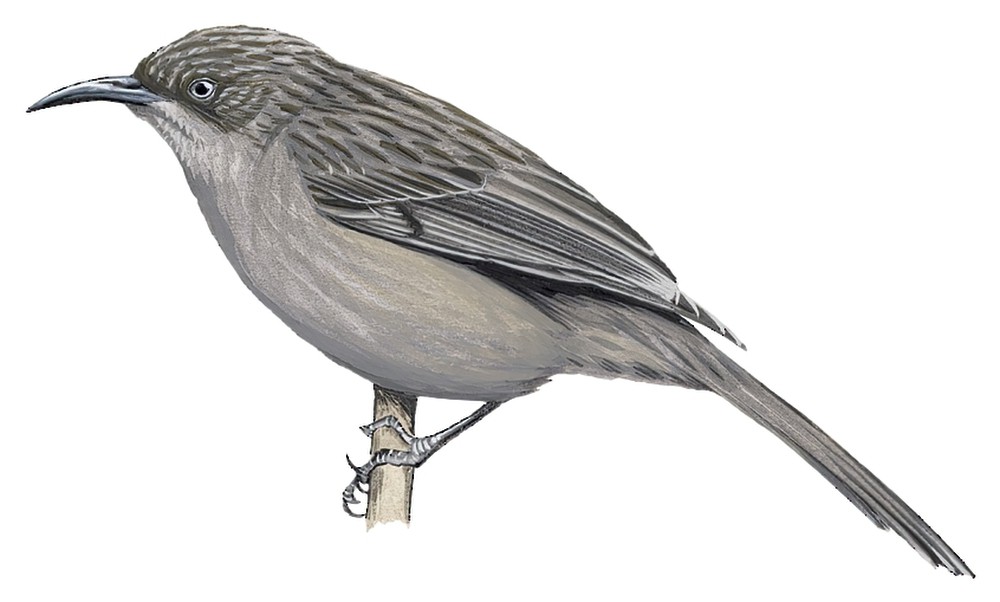Leaden Honeyeater / Ptiloprora plumbea

Leaden Honeyeater
SCI Name:
Protonym: Ptilotis plumbea Ann.Mus.Civ.Stor.Nat.Genova 34 p.151
Taxonomy: Passeriformes / Meliphagidae / Ptiloprora
Taxonomy Code: leahon1
Type Locality: Moroka, southeastern New Guinea.
Author: Salvadori
Publish Year: 1894
IUCN Status: Least Concern
DEFINITIONS
PTILOPRORA
(Meliphagidae; Ϯ Rufous-backed Honeyeater P. guisei) Gr. πτιλον ptilon feather; πρωρα prōra ship’s prow; “55. Ptilotis? guisei, n. s. ... Allied to P. erythropleura, Salvad. The feathered face, rounded tail, and want of a specialized ear-tuft should be sufficient to separate these two species from Ptilotis; a subgenus, Ptiloprora, limited by these characters, might be made for them” (DeVis 1894); "Ptiloprora De Vis, 1894, Ann. Rept. British New Guinea, 1893-94, p. 103. Type, by present designation, Ptilotis guisei De Vis.1 ... 1 No proper type selection has been made. It is usually stated that the type designation is based on monotypy, but De Vis placed both guisei and erythropleura in Ptiloprora, without choosing a generic type." (Salomonsen in Peters 1967, XII, 412).
plumbea
L. plumbeus leaden, plumbeous, lead-coloured < plumbum lead.
● ex “Garza Aplomada” of de Azara 1802-1805, no. 347 (syn. Ardea cocoi).
● ex “Spotted-tailed Hobby” of Latham 1781 (Ictinia).
● ex “Todus supra ex plumbeo canus ...” of Pallas 1769, and “Plumbeous Tody” of Latham 1782 (Polioptila).
● ex “Plumbeous Warbler” of Latham 1787 (unident.).
SUBSPECIES
Leaden Honeyeater (granti)
SCI Name: Ptiloprora plumbea granti
granti
● William Robert Ogilvie-Grant (1863-1924) English ornithologist at BMNH 1882-1918 (subsp. Acanthisitta chloris, subsp. Accipiter nisus, subsp. Aerodramus vanikorensis, syn. Alopecoenas beccarii solomonensis, subsp. Camaroptera chloronota, Horizocerus, syn. Lophura nycthemera, syn. Melaenornis pallida parvus, subsp. Microptilotis mimikae, subsp. Napothera epilepidota, syn. Neocossyphus poensis praepectoralis, Ninox, syn. Oriolus szalayi, syn. Pellorneum ruficeps olivaceum, Penelope, subsp. Ptiloprora plumbea, Ptilopsis, subsp. Rhipidura rufifrons (ex Rhipidura harterti Ogilvie-Grant), subsp. Sericornis spilodera, subsp. Sturnus vulgaris, Sula).
● Capt. Claude Henry Baxter Grant (1878-1958) British ornithologist at BMNH 1898-1903, 1932-1958, in East Africa 1916-1932 (subsp. Bradypterus lopezi, subsp. Crithagra mozambica, subsp. Cyanomitra olivacea, syn. Malimbus malimbicus, subsp. Phoeniculus damarensis, syn. Pyrenestes ostrinus minor, subsp. Sheppardia poensis, subsp. Smutsornis africanus, subsp. Terpsiphone viridis, subsp. Treron delalandii).
● Lt.-Col. James Augustus Grant (1827-1892) British Army, explorer with Speke in East Africa 1860-1863 (syn. Guttera pucherani).
● Robert Grant (1854-1923) Scottish miner and immigrant to Australia 1879, taxidermist at Australian Mus. 1887-1917, collector, explorer (subsp. Paradisaea raggiana).
Leaden Honeyeater (plumbea)
SCI Name: Ptiloprora plumbea plumbea
plumbea
L. plumbeus leaden, plumbeous, lead-coloured < plumbum lead.
● ex “Garza Aplomada” of de Azara 1802-1805, no. 347 (syn. Ardea cocoi).
● ex “Spotted-tailed Hobby” of Latham 1781 (Ictinia).
● ex “Todus supra ex plumbeo canus ...” of Pallas 1769, and “Plumbeous Tody” of Latham 1782 (Polioptila).
● ex “Plumbeous Warbler” of Latham 1787 (unident.).
UPPERCASE: current genus
Uppercase first letter: generic synonym
● and ● See: generic homonyms
lowercase: species and subspecies
●: early names, variants, mispellings
‡: extinct
†: type species
Gr.: ancient Greek
L.: Latin
<: derived from
syn: synonym of
/: separates historical and modern geographic names
ex: based on
TL: type locality
OD: original diagnosis (genus) or original description (species)












